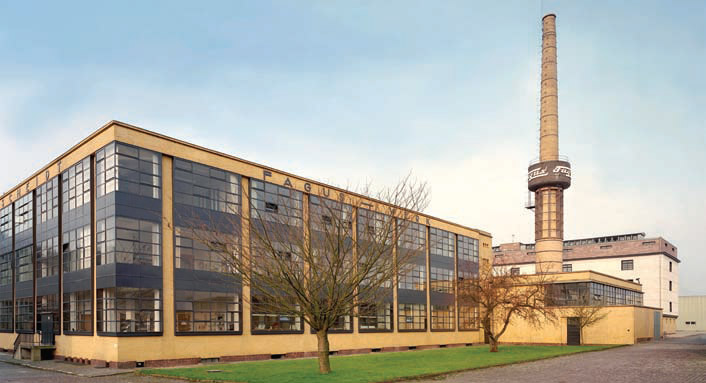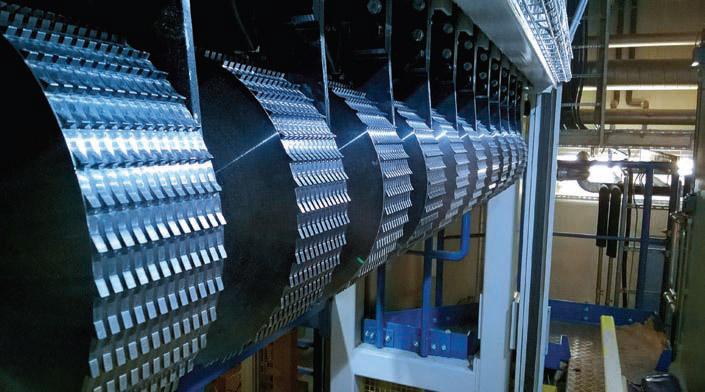GreCon builds on history
6 December 2016A cutting-edge company in a historic factory has a tradition of innovation
Call it history or call it tradition, either way GreCon undoubtably has it. How many other companies involved in the wood based panels industry can claim that their factory, built by the great-great-grandfather of the present owners, is a UNESCO World Heritage site?
GreCon makes spark detectors, sensors and measuring devices: technology at its most cutting edge. The data streams that are transforming the industry, adding layers of precision and control, and thereby quality to the product – and that are adding financial savings to the manufacturers - come in the main from GreCon. Such digitisation devices are, of course, the future.
GreCon takes the greatest pride, and with reason, not only in how they are made but where they are made. Its factory, built in 1911, joins past, present and future. It is recognised as the first building of the modern factory age.
Students of architecture come in their droves for guided tours of the building – some 18,000 last year. Since being recognised by UNESCO in 2011 the company has spent great sums on restoring and maintaining it. Astonishingly it is still perfectly adapted to the manufacturing requirements of a 21st century high-tech company. The factory and its site is rooted in living history that has relevance to how GreCon performs today.
The reason lies in the vision of the founder. This is a family concern, run now by the fifth generation down from the founding father.
First, the roots in history. (Bear with me. It all becomes relevant.) Back in 1911, in a small town by the name of Alfeld near Hanover in Germany, one Carl Benscheidt was production manager of a factory that made lasts for shoemakers – lasts being the wooden foot-shaped blocks over which the shoemakers hammered their soaked leather to form it to the shape.
He fell out with the owner, convinced that he could do things better and went off to New York to raise money; within four weeks he had raised enough to set up on his own.
Back in his home town he bought a site directly opposite that of his former employer’s works and hired an architect to design his new factory. The architect produced a perfectly adequate design for the time.
But before building could begin he met another young architect, one Walter Gropius, who was to become world famous as the founder of the Bauhaus movement but who at that time had yet to build anything. Mr Benscheidt scrapped the old plans and gave Gropius a free hand instead. It was the beginning of modern architecture.
Gropius mounted the factory’s water tank around the tall boiler-chimney to use its waste heat. The site generated its own electricity, partly from waste wood. This was in 1911: there is little new under the sun.
We visited the GreCon factory on a gloomy day. The roof windows and the glass curtain walls – suspended from the roofline, not supported from the floor, to give flexibility against cracking – gave so much natural light that only three electric lights were burning.
The whole place works well. So there is a lasting pride in the past. And it results in a lasting pride in the present and future. The family owners of GreCon are not going to betray their inheritance, their tradition, or their history.
Move forward 60 years, and three generations, to the 1970s and to brothers Gerd and Ernst Greten, Carl’s greatgrandsons. Young Ernst was an electrical engineer with a company making distance measuring devices for open presses. The family firm, in the hands of their father, was now producing lathes and other woodworking machinery, including presses for the panel industry. He said to his sons "My customers need two things: they need to measure the thickness of their fibre mats; and they have too many fires in their factories. One fire a week gets into the newspapers; one a month gets reported on TV. Solve those problems."
Mr Greten's expertise was already in measurement technology; so the brothers began making measuring devices and spark detectors. Which is what GreCon still does.
"Fires in dust-extraction units start at the filter, where the dust becomes concentrated enough to be explosive," says Mathias Fischer, sales director at GreCon. "So we make infra-red detectors to detect sparks and extinguish them upstream before they reach the filter. In measuring devices we measure before it gets expensive."
He gives a sum: "For example, a variation of 1/10mm in thickness over a 10mm board makes a difference of about 1% in material used. One cubic metre of material costs between €100 and €200; a factory can produce 2,000m3 a day. That adds up to a huge amount of money. Work out the cost of variation yourself." (I did. It comes to about €600,000 a year by my calculations, but you probably already knew that).
"So, large savings are very possible; which means that small or medium investments are more than worth it to get them," says Mr Fischer.
Hence GreCon’s ‘Formator’, an automatic control loop to reduce such fluctuations. It is a combination of the company’s existing ‘Dieffensor’, which has sold more than 75 units worldwide, and the new segmented scalper. The Dieffensor uses X-rays to detect the material fluctuations across the entire mat width before the press, to unprecedented accuracy: with a resolution of 2.5mm2 per measuring point, it records 400,000 values per m2 of mat. It also detects foreign bodies in the fibre cake. The thickness data is fed back upstream to the scalper, which selectively removes raw material from areas where the formed fibre mat is too thick and returns the surplus material to the fibre bin. Optimising the spreading of raw material results in savings on the scale calculated above.
GreCon’s target for each one of its devices is to give the customer complete return on his investment in less than 12 months. "Not all our devices reach that but many do and at least two are much better than that," says Mr Fischer, proudly. The Formator is one that does fulfil that brief. So far two have been sold to Swiss Krono, one to Egger and one to AGT in Turkey. "On our pilot plants we receive the second portion of our payment from the client only when the savings targets have been reached. Egger has paid the full bonus already, so we are quite hopeful that this technology will become standard in the industry," says Mr Fischer.
Another of GreCon's recent developments is the ‘Chipinspector' to identify, for the first time, rubber particles in raw material flow. Rubber has a similar density to wood, so it has been hard up to now automatically to identify and separate it. GreCon’s sensor uses two different energies of X-Ray diffraction to do the job. "A rubber path in the surface of a board will drop out to leave a hole," explains Mr Fischer. "Our technology can scan up to 60 tonnes an hour of chips, which would apply to a large mill. Perhaps in combination with companies selling recycling towers we can now sort out the problem of rubber."
GreCon’s spark detectors use infra-red light of different wavelengths. It sells around 1200 complete units and consoles per year, which totals around 15,000 individual sensors. "We have no real competitors, we are biggest in that niche," he says.
Fibre quality in the mat is of obvious importance and Grecon’s Fibreview measures it without the need to take samples. The surface is continually scanned by a camera and software determines and records the size and consistency of the fibre. Feedback adjusts the geometry of the refiner discs, to open or close them, or warns that it is time to change discs. Savings of up to 10kW an hour per ton of wood are claimed.
"It saves energy because refiners consume over 50% of the energy of the whole plant, and we can adjust the refiners quite nicely. We think Fibreview is something special. Swiss Krono tested it in Poland, then immediately bought five units," says Mr Fischer.
Allied to that start in visual scanning, in September this year GreCon took over a majority shareholding in Ipac, Improved Process Analytics and Control GmbH, which is based in Villach, Austria. Ipac is a leader in automated colour measurement of decorated surfaces. In printing, colour recognition and assessment – and final clearance for matching of colours – has up to now always been subjective, carried out by the human eye.
Transforming it to an objective quantified system may be an industry changer. Around 40 people work in GreCon’s R&D department. "That is not typical for a company of our size, but is a consequence of our innovation," says Mr Fischer. "We want to create new solutions that are helpful to our customers. We are not interested in short relationships with them, we want long ones for our business to stay family-owned and independent. We want to remain a family business. We have no intention of floating.
"The future is acting on measured parameters," he adds, unconsciously echoing what had been said to me at Dieffenbacher the previous day. "We have an 'Innovation Circle'. Six people meet every four weeks. It is a box of ideas, where thought can take flight: What can we do that is different?
What is the market for this idea? What is the benefit to the customer? Is there a need for it?” If so, then yes, it will be worked on.
"It allows us also to make mistakes. You have to know risk and sometimes take it on. Carl Benscheidt took an immense risk with a young architect, entrusted a huge project to him. That trust and leadership are still alive in the company.
“Our biggest capital is not what we have in the bank, but is our workers,” said founder Carl Benscheidt; and that is still true."

